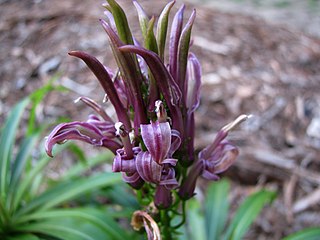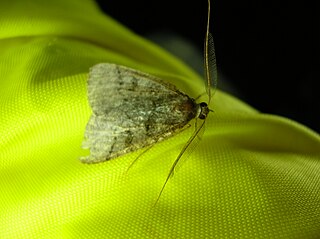External links
- Zimmerman, Elwood C. (1958). Insects of Hawaii. 7 Macrolepidoptera. University of Hawaii Press, Honolulu. hdl:10125/7336.
| This Boarmiini-related article is a stub. You can help Wikipedia by expanding it. |
| Scotorythra nephelosticta | |
|---|---|
| Scientific classification | |
| Kingdom: | |
| Phylum: | |
| Class: | |
| Order: | |
| Family: | |
| Genus: | |
| Species: | S. nephelosticta |
| Binomial name | |
| Scotorythra nephelosticta Meyrick, 1899 | |
Scotorythra nephelosticta is a moth of the family Geometridae. It was first described by Edward Meyrick in 1899. It is endemic to the Hawaiian islands of Kauai and Oahu.
| This Boarmiini-related article is a stub. You can help Wikipedia by expanding it. |
Located about 2300 miles (3680 km) from the nearest continental shore, the Hawaiian Islands are the most isolated group of islands on the planet. The plant and animal life of the Hawaiian archipelago is the result of early, very infrequent colonizations of arriving species and the slow evolution of those species—in isolation from the rest of the world's flora and fauna—over a period of at least 5 million years. As a consequence, Hawai'i is home to a large number of endemic species. The radiation of species described by Charles Darwin in the Galapagos Islands which was critical to the formulation of his theory of evolution is far exceeded in the more isolated Hawaiian Islands.

Hurricane Iwa, taken from the Hawaiian language name for the frigatebird, was at the time the costliest hurricane to affect the state of Hawaiʻi. Iwa was the twenty-third tropical storm and the twelfth and final hurricane of the 1982 Pacific hurricane season. It developed from an active trough of low pressure near the equator on November 19. The storm moved erratically northward until becoming a hurricane on November 23 when it began accelerating to the northeast in response to strong upper-level flow from the north. Iwa passed within 25 miles of the island of Kauaʻi with peak winds of 90 mph (145 km/h) on November 23, and the next day it became extratropical to the northeast of the state.

The Hawaiian lobelioids are a group of flowering plants in the bellflower family, Campanulaceae, all of which are endemic to the Hawaiian Islands. This is the largest plant radiation in the Hawaiian Islands, and indeed the largest on any island archipelago, with over 125 species. The six genera can be broadly separated based on growth habit: Clermontia are typically branched shrubs or small trees, up to 7 metres (23 ft) tall, with fleshy fruits; Cyanea and Delissea are typically unbranched or branching only at the base, with a cluster of relatively broad leaves at the apex and fleshy fruits; Lobelia and Trematolobelia have long thin leaves down a single, non-woody stem and capsular fruits with wind-dispersed seeds; and the peculiar Brighamia have a short, thick stem with a dense cluster of broad leaves, elongate white flowers, and capsular fruits.

Wikstroemia is a genus of 55-70 species of flowering shrubs and small trees in the mezereon family, Thymelaeaceae. Hawaiian species are known by the common name ‘ākia.

Scotorythra is a genus of moths in the family Geometridae erected by Arthur Gardiner Butler in 1883. All species of this genus are endemic to Hawaii.

The energy sector in Hawaii has rapidly adopted solar power due to the high costs of electricity, and good solar resources, and has one of the highest per capita rates of solar power in the United States. Hawaii's imported energy costs, mostly for imported petroleum and coal, are three to four times higher than the mainland, so Hawaii has motivation to become one of the highest users of solar energy. Hawaii was the first state in the United States to reach grid parity for photovoltaics. Its tropical location provides abundant ambient energy.
Scotorythra euryphaea is a moth of the family Geometridae. It was first described by Edward Meyrick in 1899. It is endemic to the Hawaiian islands of Kauai, Oahu, Molokai and Maui.
Scotorythra hecataea is a moth of the family Geometridae. It was first described by Edward Meyrick in 1899. It is endemic to the Hawaiian islands of Kauai and Oahu.
Scotorythra oxyphractis is a moth of the family Geometridae. It was first described by Edward Meyrick in 1899. It is endemic to the Hawaiian islands of Kauai, Oahu, Molokai and Hawaii.
Scotorythra pachyspila is a moth of the family Geometridae. It was first described by Edward Meyrick in 1899. It is endemic to the Hawaiian islands of Kauai, Oahu, Maui, Lanai and Hawaii
Scotorythra trapezias is a moth of the family Geometridae. It was first described by Edward Meyrick in 1899.
Scotorythra arboricolans is a moth of the family Geometridae. It was first described by Arthur Gardiner Butler in 1883. It is endemic to the Hawaiian islands of Kauai, Oahu, Molokai, Maui, Lanai and Hawaii
Scotorythra brunnea is a moth of the family Geometridae. It was first described by William Warren in 1896. It is endemic to the Hawaiian islands of Kauai, Oahu, Molokai, Maui and Hawaii.
Scotorythra caryopis is a moth of the family Geometridae. It was first described by Edward Meyrick in 1899. It is endemic to the Hawaiian islands of Kauai and Oahu.

Scotorythra paludicola, the koa looper moth, is a moth of the family Geometridae. It was first described by Arthur Gardiner Butler in 1879. It is endemic to the Hawaiian islands of Kauai, Oahu, Maui and Hawaii.

Scotorythra rara is a moth of the family Geometridae. It was first described by Arthur Gardiner Butler in 1879. It is endemic to the Hawaiian islands of Kauai, Oahu, Molokai, Maui and Hawaii.